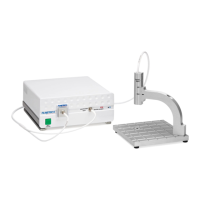2. The Edit menu is used for viewing and editing the material library.
3. Used to Setup various parameters and the graphic display.
4. For starting and stopping continuous reflectance acquisition and data measurement.
5. Used to access the Help, Diagnostic and Support functions of the software.
6. Shows that the Measure tab is currently selected.
7. Used to select the History tab.
8. This is the thickness result from the measured spectrum.
9. This button causes spectra to be acquired and analyzed.
10. The baseline measurement sequence, which is required before measurements are made, is ini-
tiated by pressing the Baseline button.
11. This button analyzes the selected spectra.
12. This is used to select Recipe settings that correspond to different samples to be measured.
13. This is where the Recipe (the film stack definition and data acquisition and analysis settings) is
set. Hundreds of recipes can be saved and later recalled.
14. This box provides more details about the calculated thickness, as well as any additional param-
eters that were solved for, including Roughness, n and k, and Non-Uniformity as well as the
Goodness of Fit (GOF).
15. Graphical display for spectra. A click of the right mouse button while the cursor is within the
graphical display activates a blue line (one click for measured curve) for easy reading of cursor
values in the main FILMeasure window. Keyboard up/down and right/left arrows move the line to
a desired location.
The graph limits can be changed by double-clicking on the graph display. The Horizontal Axis
Minimum and Maximum fields are used to control the wavelength range displayed on the screen.
Use the Vertical Axis Minimum and Maximum fields to control the vertical-axis display. Check
the Autoscale Maximum checkbox to activate y-axis autoscaling. The lower value is always 0 for
autoscaling; the maximum y-axis upper limit is 5000. Changing the Vertical Axis will change the
reflectance axis, the Vertical Axis 2 will change the transmittance axis. The axes can be set to dis-
play in percent or as a decimal value (100% = 1).

